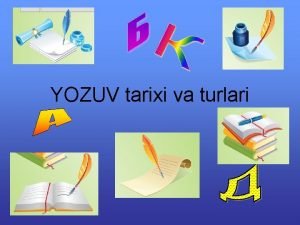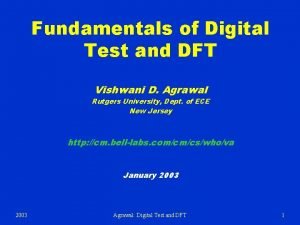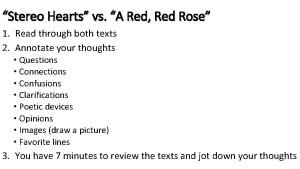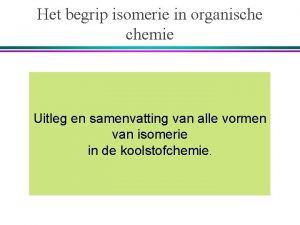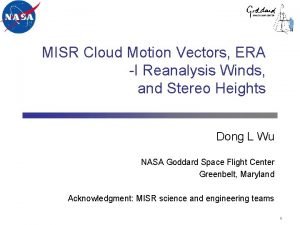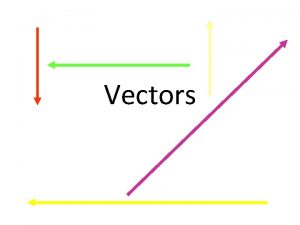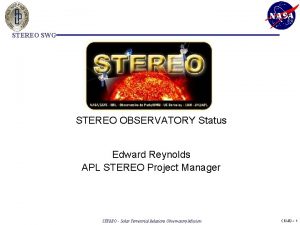Status of MISR Stereo Motion Vectors and Assessment













- Slides: 13

Status of MISR Stereo Motion Vectors and Assessment using MODIS, MSG, & CATS lidar Kevin J. Mueller 1 1 Jet Propulsion Laboratory, California Institute of Technology, Pasadena, CA

Multi-angle Imaging Spectro. Radiometer MISR instrument Mission Lifetime • • Cr ck tra sos 1999 -> 2018+ 2026 Orbit change in 2022 Swath Width ~ 380 km 9 Camera View Angles • • • Up • 0º (Nadir) ± 26. 1º, ± 45. 6º ± 60. 0º, ± 70. 5º 7 minute overpass Cro ss ra -t ng ck 275 m for Nadir and Red Band 1100 m all else Along-track ck Alo B, G, R, & NIR Bands Spatial Resolution • • -tra tes u in ∆t m 7 ~ MISR Wind Products • Stereo Motion Vectors (SMV) • Geometric height obtained from parallax • Retrieved from redundant forward and aft camera triplets • Time interval ∆t = 200 seconds • Gridded resolution ∆x = 17. 6 km • Height-resolved cross-track cloud motions: • Geometric height obtained from parallax • Retrieved from redundant forward and aft camera pairs • Time interval ∆t = 46 seconds • Gridded resolution ∆x = 1. 1 km 2

MISR Stereo Motion Vectors status • Forecast benefit in GMAO GEOS-5 model shown • Mueller et al. 2017, MWR • GMAO following up by incorporating code into operational GEOS 5 -FP • Testing in progress after updating code from paper to current GEOS 5 revision • Two years of NWPSAF monitoring show well constrained error • NWPSAF AMV Analysis reports show 2 caveats: • occasional orbits with poor georegistration have systematic bias and degraded forecast benefit • MISR SMV will benefit from major upstream revisions to Level 1 software • New DEM and revised camera model will benefit georegistration • MISR SMV are highly sensitive to georegistration- see above 2018 -04 -23 3

Example MISR Wind Product Retrievals Height resolved cloud motion vectors (17. 6 km resolution) (Hurricane Francis) Height resolved cross-track cloud motion (1. 1 km resolution) (Hurricane Ida) Height (meters) 4

Research retrieval: 4. 4 km resolution Speed 20 m/s 9000 Height (m) 6000 3000 2018 -04 -23 0 5

Prototype: divergence @ 4. 4 km 0. 4 0 Divergence (s-1 × 10 -3) 0. 2 -0. 4 2018 -04 -23 6

Questions from past SMV assessment • Comparison of MISR with GOES AMV (2003 -2008) • Mueller et al. , 2017 JAMC • MISR and GOES wind tracking agree well • 3. 2 m s-1 VRMS (VIS channel) • 1. 6 m s-1 RMS cross-track • Except for… • (2) Low heights (< 4 km): • Heights uncorrelated • MISR often 2 km below GOES • (3) High heights (> 8 km) • MISR often 1 km above GOES • Can analysis be corroborated / expanded with “truth” data for heights? 2018 -04 -23 7

MISR SMV height validation with CATS • 10 s of thousands of well distributed spatial coincidences within 5 minutes, 2015 -2017 • Latitude range 52° S. to 52° N • Coincidences with poor MISR orbit registration have been excluded Locations and heights (m) of coincidences Height distribution of collocations

Lidar heights compare favorably with SMV heights • Directly comparable measurements yield low noise MISR vs. GOES height • RMS 300 m MISR height (km) 2018 -04 -23 MODIS vs. CATS height MODIS height (km) MISR vs. CATS height (km) 9

MISR stereo prefers optically thick, water clouds (possible bias in other clouds) • Ice and unkown phase clouds have double the height variance relative to CATS • Liquid phase σ = 260 m, ice & unknown phase σ = 500 m • With decreasing optical depth, height “bias” relative to CATS increases from -250 m to -30 m • Would these patterns hold for along-track variance and bias? Ice & unknown phase, bias as function of tau Frequency Liquid phase, bias as function of tau (at 1064 nm) MISR height minus CATS height (m)

Additionally collocated MSG AMV shows SMV along-track bias may follows height bias • Pattern of SMV along-track bias vs. MSG AMV follows that of SMV vs. CATS height • Positive/negative along-track bias at positive/negative fringes of height distribution which • For low clouds: 5 MISR along-track bias 0 0 0 2018 -04 -23 CATS Height (km) 5 0 CATS Height (km) 5 Wind Component (m/s) MISR cross-track bias MISR Height (km) Frequency 5 5 5 • height σ=600 m, along-track σ=3. 5 m/s, cross-track σ=2. 5 m/s -5 11

Low optical depth ice clouds (cirrus? ) produce along-track biased retrievals • The fringes of the prior distribution show the source of bias to be ice in prior distribution 2018 -04 -23 12

Conclusions and follow up work • Ice clouds are a source of positive along-track bias in MISR SMVs, and may be the dominant source • Can a scheme for flagging ice clouds be used to improve robustness of MISR SMVs 2018 -04 -23 13
 In her physics lab melanie rolls
In her physics lab melanie rolls Misr for central clearing, depository and registry
Misr for central clearing, depository and registry Misr joylashgan qit'a
Misr joylashgan qit'a Qadimgi misr madaniyati slayd
Qadimgi misr madaniyati slayd Yozuv bu
Yozuv bu Misr dft
Misr dft Arab republic of egypt
Arab republic of egypt Pedagogik fikrlar
Pedagogik fikrlar Misr arab respublikasi
Misr arab respublikasi Simile in stereo hearts
Simile in stereo hearts Motion and types of motion
Motion and types of motion Tcp stereo
Tcp stereo Inwendig spiegelvlak
Inwendig spiegelvlak Stereo isomerie
Stereo isomerie




